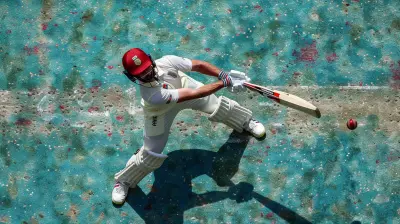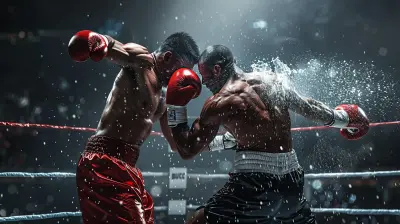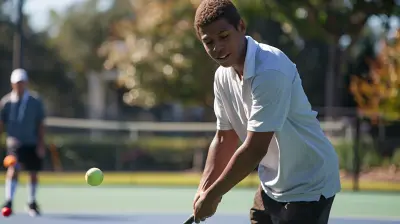The Science of Pressing Traps in Football
10 March 2025
Football is constantly evolving, and with it come new strategies that change the way teams approach the game. One such tactic that has gained massive popularity, especially in the modern era, is the "pressing trap." If you've ever watched a high-intensity match and wondered how teams seem to magically win the ball back in dangerous areas, you're likely witnessing a well-executed pressing trap.
But what exactly is a pressing trap, and why is it so effective? Let's dive into the science behind pressing traps in football, breaking down the tactical, psychological, and physical principles that make them a game-changer.

What Is a Pressing Trap?
To put it simply, a pressing trap is a tactical maneuver where a defending team lures the opponent into a specific area of the pitch with the intention of winning the ball back. Rather than pressuring the opponent all over the field, the defending team carefully allows the opposition to play into certain zones before springing their press. The goal is to limit the opponent's passing options and force a mistake, leading to a turnover in a dangerous position.Imagine you're going fishing. You set the bait, patiently wait, and when the fish bites, you reel it in. That’s pretty much what happens in a pressing trap. The defending team lays the "bait" by leaving certain areas of the pitch open, enticing the opponent to play into that space. Once the ball enters the targeted area, the trap is sprung, and the defending team applies intense pressure to win possession.

Why Are Pressing Traps So Effective?
Pressing traps are a strategic masterpiece for several reasons:1. Forces Opponents into Predictable Patterns: By controlling where the ball goes, the defending team can predict the opponent's next move. It's like playing chess, where you guide your opponent into a corner before making your decisive moves.
2. Creates Overloads: Once the ball is in the targeted zone, the defending team can swarm the ball carrier, creating numerical superiority. This makes it harder for the opposition to find a safe pass and increases the chance of a turnover.
3. High-Risk, High-Reward: While pressing traps can be risky—because if the press is broken, the opponent might have space to counter—when executed well, they lead to high-quality goal-scoring opportunities. Winning the ball high up the pitch often leaves the opposition disorganized and vulnerable.

The Psychology Behind Pressing Traps
Let's not forget the psychological side of pressing traps. Football is as much a mental game as it is a physical one. Pressing traps exploit human tendencies and decision-making under pressure.When players are under pressure, especially in tight spaces, they are more likely to make mistakes. It’s human nature. You panic, your decision-making slows down, and suddenly, that simple pass becomes a challenge. Pressing traps create an environment where the opponent feels boxed in, increasing the likelihood of forced errors.
Additionally, pressing traps mess with the opponent's rhythm. In possession-based football, teams rely on smooth passing and movement to control the game. A well-timed pressing trap disrupts this flow, frustrating the opponent and making them second-guess their decisions.

Types of Pressing Traps
There isn’t just one way to set a pressing trap. Coaches and teams use different types of pressing traps depending on their playing style, the opposition, and the game situation. Here are a few common pressing traps used by top teams:1. Sideline Trap
The sideline trap is one of the most frequently used pressing traps. The idea here is to herd the ball towards the touchline, where the opponent has fewer passing options. Once near the sideline, the defending team closes in quickly, cutting off escape routes and forcing the ball carrier to either make a risky pass or lose possession.The sideline acts almost like a second defender, effectively narrowing the field and reducing the space the opposition can use. It’s like trapping someone in a corner in a game of tag—there’s nowhere to go!
2. Central Trap
While the sideline trap is about pushing the opponent wide, the central trap works in the opposite direction. In this case, the defending team intentionally leaves central areas open, baiting the opponent to pass into the middle of the pitch. Once the ball arrives in this congested space, the defending team pounces, overwhelming the ball carrier with quick pressure.Central traps are particularly effective because any turnover in the middle of the pitch allows the defending team to attack immediately with the entire field ahead of them. A well-executed central trap can lead to a fast counterattack and a high-quality scoring opportunity.
3. Third-Man Trap
This is a more advanced pressing trap that involves using the positioning of the "third man." In football, the third man refers to a player who is not directly involved in the initial pass but is the next passing option. In a third-man trap, the defending team allows the ball to be passed between two players, only to spring the press once the ball reaches the third man.The key here is to lull the opposition into a false sense of security by allowing the first two passes to happen uncontested. Once the ball reaches the third man, the pressing team triggers their trap, catching the opposition off guard.
How Teams Set Up Pressing Traps
Setting up a pressing trap requires coordination, timing, and discipline. It’s not just about running at the ball carrier with reckless abandon. Every player has a role, and the trap needs to be executed as a team. Here’s a step-by-step breakdown of how teams set up pressing traps:Step 1: Shape and Organization
The first step is setting up the team’s defensive shape. Pressing traps often start from a mid-block or low-block defensive setup, where the defending team sits deeper on the pitch. The key is to maintain compactness and ensure that players stay close together, reducing the space the opponent can exploit.Step 2: Guiding the Opponent's Play
Once the defending team is organized, the next step is to guide the opponent’s play into the desired area. This is done through subtle body positioning and movement. For example, the defending team might allow the opposition to play out wide, while cutting off the central passing lanes. This forces the ball into the targeted zone, setting the stage for the trap.Step 3: Triggering the Press
As soon as the ball enters the targeted area, the defending team springs into action. This is where pressing traps are made or broken. Timing is everything. The players closest to the ball immediately apply pressure, while their teammates cut off passing options, ensuring the opponent has nowhere to go.Step 4: Winning the Ball
The final step is winning the ball. Ideally, the intense pressure forces the opponent to make a mistake—either a misplaced pass, a poor touch, or a turnover. Once the ball is won, the defending team can transition quickly into attack, catching the opposition off balance.
The Role of Communication and Coordination
Pressing traps are a team effort. It’s not just about one or two players chasing the ball; it requires coordination across the entire team. Communication is key. Players need to constantly talk to each other, ensuring everyone is on the same page. If one player presses at the wrong time or in the wrong direction, the entire trap can fall apart.Additionally, pressing traps require high levels of fitness and concentration. Players need to be sharp both mentally and physically, as pressing is demanding work. A successful trap can be exhausting, but the potential rewards—winning the ball in a dangerous area and creating a goal-scoring opportunity—are worth the effort.
Examples of Pressing Traps in Modern Football
Some of the best teams in the world have mastered pressing traps. Managers like Jürgen Klopp, Pep Guardiola, and Diego Simeone have made pressing traps a central part of their tactical arsenal.Klopp’s Liverpool, for instance, is famous for their aggressive “gegenpressing,” a style of play that revolves around winning the ball back immediately after losing it. In many cases, Liverpool’s players set pressing traps, forcing the opponent into tight spaces before overwhelming them with quick pressure.
Guardiola’s Manchester City, on the other hand, employs a more controlled pressing system, often using pressing traps to win the ball back in central areas after inviting the opposition into the middle.
Simeone’s Atletico Madrid takes a more defensive approach, often sitting deep and using pressing traps in their own half to launch counterattacks.
Conclusion
Pressing traps are a fascinating blend of tactics, psychology, and physicality. They can be the difference between winning and losing in the modern game, especially when executed with precision. By luring the opposition into specific areas and applying intense, coordinated pressure, teams can win the ball back in dangerous positions and create high-quality chances.Whether it’s the sideline trap, central trap, or third-man trap, pressing traps are a powerful tool in any team’s tactical toolbox. But like all tactics, they require discipline, communication, and impeccable timing. When done right, they can turn defense into attack in the blink of an eye.
So, the next time you watch a game, keep an eye out for these pressing traps. You might just see the science of football in action.
all images in this post were generated using AI tools
Category:
TacticsAuthor:

Ruben McCloud
Discussion
rate this article
16 comments
Haven Hudson
Great article! It's fascinating how pressing traps can change the game dynamics. Can't wait to see more teams utilize this strategy!
April 8, 2025 at 10:34 AM

Ruben McCloud
Thank you! I'm glad you found it fascinating. Exciting times ahead as more teams adopt this strategy!
Anna McGonagle
The intricacies of pressing traps in football reveal more than tactical prowess; they illuminate the delicate balance between chaos and order. Each movement is a dance of anticipation and reaction, challenging players to harmonize instinct with strategy, ultimately redefining control in the beautiful game.
April 1, 2025 at 6:29 PM

Ruben McCloud
Thank you for your insightful comment! You perfectly capture the essence of pressing traps as a blend of instinctive movement and tactical strategy in football.
Ingrid Hayes
Great insights on pressing traps! Understanding the science behind it will definitely elevate our gameplay. Excited to see how teams implement these strategies on the field!
March 31, 2025 at 11:59 AM

Ruben McCloud
Thank you! I'm glad you found the insights valuable. Excited to see how teams apply these strategies too!
Kevin Sawyer
Great article! The analysis of pressing traps in football highlights the intricate balance between strategy and player execution. Understanding the underlying science not only enhances appreciation for the game but also informs coaching techniques. Looking forward to more insights on this topic!
March 29, 2025 at 11:54 AM

Ruben McCloud
Thank you for your feedback! I'm glad you found the analysis insightful. Stay tuned for more in-depth discussions on this topic!
Eliza Long
Ah, the pressing trap—a tactic so cunning even Houdini would raise an eyebrow! It’s like trying to catch a greased pig at a county fair; one wrong move, and you’re left with nothing but a face full of turf and a puzzled expression. Football: where science meets slapstick!
March 27, 2025 at 9:39 PM

Ruben McCloud
Thank you for the clever analogy! Pressing traps truly blend strategy and excitement in football, making every moment unpredictable.
Kaitlin McTier
Sure, pressing traps sound fancy, but let's be real: if your players can’t execute it under pressure, it’s just another tactic collecting dust! Time to see who can actually *trap* that ball!
March 26, 2025 at 9:01 PM

Ruben McCloud
You make a great point! Execution under pressure is key, and that's what truly separates effective tactics from theory. It's all about practice and adaptability on the field!
Melody Clayton
Insightful read, truly appreciate this!
March 26, 2025 at 1:44 PM

Ruben McCloud
Thank you! I'm glad you found it insightful!
Trixie Carter
Fascinating article! I'm curious how the principles of pressing traps can be applied across different football formations. Do you think the effectiveness varies with player skill levels? Also, how crucial is communication between players to execute these tactics successfully? Would love to hear more!
March 26, 2025 at 4:09 AM

Ruben McCloud
Thank you for your interest! Yes, pressing traps can be adapted to various formations, and their effectiveness often depends on player skill levels. Communication is indeed crucial for executing these tactics successfully, as it ensures players work cohesively. Happy to delve deeper into this in future discussions!
Vanta Powell
Ah yes, the pressing trap—because nothing screams 'football genius' like overcomplicating something that basically just means 'chase the ball!'
March 24, 2025 at 11:18 AM

Ruben McCloud
Thank you for your comment! While it may seem simple, pressing traps are about strategic positioning and teamwork to regain possession effectively.
Rivenheart Huffman
Great article on pressing traps in football! The insights on its tactical implications and player positioning are particularly enlightening. Keep up the excellent work!
March 22, 2025 at 7:51 PM

Ruben McCloud
Thank you for your kind words! I'm glad you found the insights enlightening. I appreciate your support!
Evangeline McGehee
Great insights on pressing traps! Understanding the science behind tactics really enhances our appreciation for the game.
March 21, 2025 at 12:55 PM

Ruben McCloud
Thank you! I'm glad you found the insights valuable. Understanding the science truly deepens our appreciation of the game's tactics!
Gunnar Maddox
Great insights! I appreciate the depth of analysis on pressing traps.
March 20, 2025 at 8:41 PM

Ruben McCloud
Thank you! I'm glad you found the analysis valuable.
Blair Thompson
Essential strategy for modern football.
March 20, 2025 at 1:15 PM

Ruben McCloud
Thank you! Pressing traps are indeed crucial for modern football, enhancing both defensive organization and offensive opportunities.
Orionis Sweeney
This article brilliantly dissects the tactical nuances of pressing traps in football, illustrating how understanding spatial dynamics can turn defense into a powerful offensive weapon.
March 20, 2025 at 4:40 AM

Ruben McCloud
Thank you for your insightful comment! I'm glad you found the article illuminating and appreciate your engagement with the tactical aspects of pressing traps.
Foster McInnes
Great article! Your insights on pressing traps provide a deeper understanding of this tactical approach in football. It’s fascinating how science can enhance strategy and performance on the field. Keep up the great work!
March 17, 2025 at 9:57 PM

Ruben McCloud
Thank you for your kind words! I'm glad you found the insights valuable. Your support means a lot!
Tilly Kirkland
This article sheds light on the often-overlooked tactics behind pressing traps in football. It's fascinating to see how science and strategy intertwine to enhance team performance. Understanding these concepts not only deepens our appreciation for the game but also highlights the importance of meticulous planning in achieving success on the pitch.
March 17, 2025 at 2:04 PM

Ruben McCloud
Thank you for your insightful comment! I'm glad you found the article illuminating and appreciate the intersection of science and strategy in football. Understanding these tactics truly enhances our love for the game!
MORE POSTS

Yoga for Desk Workers: Poses to Counteract Sitting All Day

Why Fielding is the Unsung Hero of Modern Cricket

Betting on Combat Sports: Boxing and MMA Betting Tips

How to Choose the Right Protective Gear for Contact Sports

The Rise of Women’s Cricket: A Game-Changer in the Sport

The Global Reach of Charity Sports: Stories from Around the World

The Art of Passing: Improving Team Efficiency

Tackling Social Issues Through Charity Sports Initiatives

Celebrity Athletes Making a Difference in Charity Tournaments

The Gear You Need for a Successful Triathlon